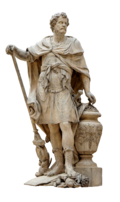Initial assault
When the Roman consuls Manius Manilius and Lucius Marcius Censorinus made their beachhead at Carthage, they deployed separately in two different locations; Manilius set up his camp on the isthmus leading up to the city, directly facing the citadel of Byrsa, while Censorinus made his encampment on the shore of Lake Tunis, opposite the western wall of Carthage. Manilius planned to fill the ditch facing the southern wall and from there scale it, while Censorinus intended to raise ladders to the western wall from the ground and the decks of the ships. Two initial assaults were made. The consuls thought the Carthaginians were without arms, but they were surprised to find the citizens re-armed, and both attempts were repelled. Fearing the approach of Hasdrubal the Boetharch, who was encamped on the other side of Lake Tunis, each consul fortified his camp. [Appian 1]
Surprise attack on Censorinus's camp
After fortifying his camp, Censorinus dispatched his men to gather timber from the far side of Lake Tunis, intending to build new siege engines. Himilco Phameas, the Carthaginian cavalry commander, seized this opportunity to attack the gatherers, resulting in a loss of 500 Roman soldiers and a great deal of tools for constructing siege works. Nevertheless, Censorinus acquired sufficient timber to build siege engines and ladders, and he and Manilius launched another attack on the city in concert, which was again repulsed. [Appian 2] Manilius decided against launching another assault on the walls from the isthmus, but Censorinus, having filled up parts of the lake to provide room, constructed two battering rams, one for his fleet and another supported by 6000 infantry. In the subsequent assault on the walls from Lake Tunis, his troops managed to breach Carthage's wall before being driven off by the defenders, who hastily began repairing the breach. Fearing a second assault, the Carthaginians sallied from the unrepaired wall that evening and assaulted the camp on Lake Tunis, burning many of the Roman siege engines. [Appian 3]
The next day, the Roman troops attempted to break through the gap in the wall, though Scipio Aemilianus, then serving as military tribune under Censorinus, refused to enter and held his troops in reserve, instead spacing them at regular intervals along the wall. While Aemilianus's troops avoided battle, the other troops were met by staunch resistance in the gap, suffering heavy casualties. [Appian 4]
Roman withdrawal and fire attack
Around 27 July - at the appearance of Sirius on the horizon at sunrise - Censorinus faced an epidemic in his ranks, having kept his troops on stagnant water with poor airflow from the sea over Carthage's walls. Accordingly, he relocated his camp to a site on the shore of the sea. The Carthaginians, noting the movement of the Roman fleet, constructed fire ships in their harbour and launched them along the coastline when the Roman fleet came into view. The resulting fire attack destroyed most of the Roman fleet, and substantially set back the Roman assault. Shortly afterwards, Censorinus returned to Rome to conduct elections, and the attacks on Manilius increased in intensity. [Appian 5]
This page is based on this
Wikipedia article Text is available under the
CC BY-SA 4.0 license; additional terms may apply.
Images, videos and audio are available under their respective licenses.

